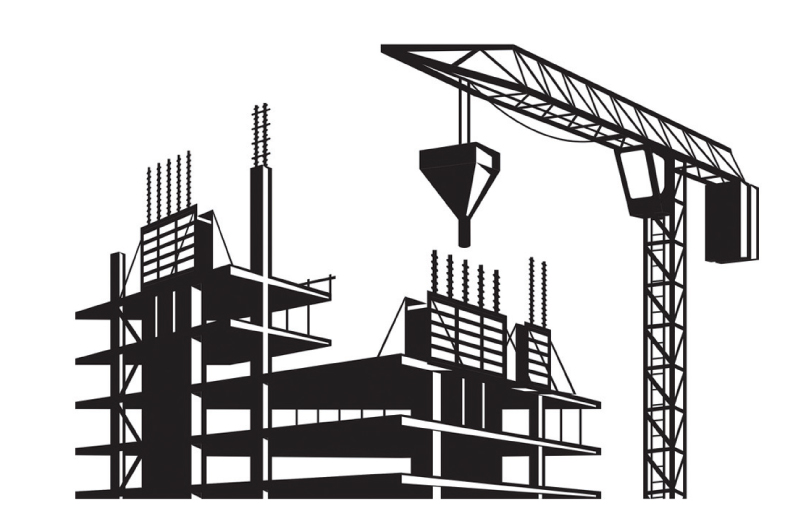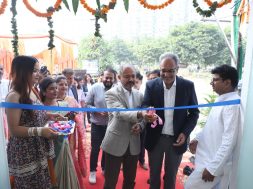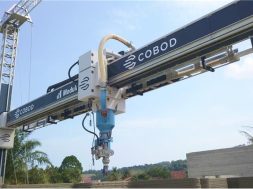Making construction sustainable, eco-friendly

Green construction methods and materials support local business besides aiding sustainability.
Global issues of climate change, resource depletion, environmental pollution and peak oil are among the major challenges currently, which need immediate addressal. These issues are acquiring serious proportions with hectic pace of industrial operations, urban development and other forms of economic activities. There is growing consensus that the building industry has strong links with the acceleration of environmental degradation.
Adapting green methods
Scientists and the oil industry are of the opinion that the world is going to reach peak oil in the next twenty years and perhaps that stage has been reached already. According to Vijay Kalantri, Chairman and Managing Director, Balaji Infra Projects, global demand of oil is soaring, whilst global production is depleting and oil is set to become increasingly scarce and expensive. Oil is a critical input for the building industry and the industry is hugely dependent on cheap oil, from the manufacture and transportation of its materials to the machinery and tools used in demolition and construction. On site construction activities also add to the air, soil and water pollution, and million tonnes of landfill waste.
As declining fossil fuels and the threat of global climate change looms large, there is growing concern to seek survival strategy. Increasingly the building industry is gearing towards green methods of construction to save energy. Kalantri says, “Green products ensure that very little energy went into their manufacture and production, with a direct reduction in carbon emissions. Eco- friendly design methodology can further reduce energy consumption by minimising energy inputs for heating, cooling and light, and incorporating energy efficient appliances.”
New construction technology and methodologies
Road making is a complex process, where numerous challenges await road construction sector like cheaper and better production, construction and maintenance. Road making challenges have intensified as raw materials are becoming scarce and the environmental laws are getting stricter with regards to air pollution and noise disturbances.
Ratan Lal Kashyap, Sr. Vice President –Procurement, G R Infraprojects Ltd says, “G R Infraprojects is one among the first Indian companies introducing use of new construction technology and construction methodologies which have brought in value in terms of quality, cost, faster execution, reuse of reclaimed material at site which has resulted in saving our environment.”
• To reduce the level of energy consumption, warm-mix asphalt (WMA) is used to replace hot-mix asphalt (HMA). Besides the fact that WMA is produced at a lower temperature, it also induces great benefits such as an improvement of working conditions (less exposure to heat and fumes) and asphalt compaction, reduction of paving cost and longer hauling. While executing various highway projects G R Infraprojects uses eco-friendly technology to protect the environment e.g. ‘Warm Mix Technology’, wherein heating of bitumen mix was done at 140C and laid at 130C instead of the requisite temperatures of 190C and 180C respectively in normal practice, which has resulted in the significant reduction of temperatures to the tune of 50C. Such drastic reductions have the obvious benefits of decreasing production of greenhouse gases and cutting fuel consumption. Hot mix plants deployed in the sites were fully compliant with the internal pollution norms. It eliminates the disposal problem and can be done repeatedly using the same material. The recycling and re-use of the waste material ensures minimum wastage and damage to environment.
• Use of RAP: Usage of Reclaimed Asphalt Pavement (RAP) has enabled long-term sustainability of roads and being eco-friendly enhances the overall growth of the infrastructure sector.
• Use of manufactured sand: G R Infraprojects has installed sanders which helps them to crush sand as per required quality parameters. It helps retain the original sand available thereby complying with sand mining prohibition made by environmental agencies of government.
• Use of crushed sand in construction: There is another way where the company uses equipment like dry sand classifiers which helps in segregating ultrafine and help match the gradation required for the construction activity. With the use of such equipment, the company is adding value and making optimum use of the available resources without damaging environment.
Foremost techniques
Sustainable architecture looks to improve the quality of human life by supporting the health and well-being of natural environments. Designing apartments with zero wastage leads to reduction in the construction area thus leads to reduction in concrete consumption.
Farshid Cooper, Managing Director, Spenta Corporation says, “As a design philosophy, we do a wind and shadow analysis; this helps us in designing an apartment which has abundant natural light and better air circulation, all this leads to lower electricity consumption.”
Solar panels, rainwater harvesting system and sewage treatment plant plays a big role in sustainability. Solar panels help in powering the common utilities of real estate development thereby reducing the dependency on fossil fuel generated electricity. In an era where the water table is lowering down rapidly, installing rainwater harvesting system helps in recharging the groundwater. Sewage treatment plant treats the wastewater generated from households and makes it reusable for activities such as toilet flushing, gardening etc. This results in a reduction of water requirement by 40 per cent. Urban greenery and vertical gardens are the modern way of sustainable construction.
Adding sustainability
Eco- friendly construction helps create a better outdoor environment as also helps to build a healthier indoor environment. This is one of the key priorities of the construction industry today. There are many good reasons for using eco-friendly construction methods and materials. It sustains our planet and improves the health of the people. It also supports local business and helps strengthen the local economy, which in turn helps to build strong and vibrant communities.
Green building is an absolute necessity for our future. The construction industry must adopt eco-friendly practices and materials that reduce its impacts in order to reduce damage to life supporting systems so that the future generations can look forward to a healthier planet to live in. The industry needs to take its own initiative and find alternative ways to build, using green, renewable energy sources, and adopt non- polluting practices and materials that reduce, recycle and reuse in order to lessen the impacts of carbon emissions.
Kalantri says, “There are really two ways to be eco-friendly in selecting building materials. The first is to choose materials that minimise environment impact. The second way is to choose materials that will promote sustainable energy. Sustainable, green building naturally insulates home from both heat and cold. It therefore cuts down on energy consumption, leading to less use of natural resources that cause climate change warming, such as oil and gas.”
Focus on sustainable alternatives
Buildings can continue to be a direct cause of pollution because of the emissions produced in them or their impact on the ground. Thus, construction can be a great consumer of natural resources such as wood, minerals, water and energy. While constructing, architects and construction professionals must look toward more sustainable alternatives such as hempcrete, light-weight materials that can drastically reduce the energy that contribute to concrete blocks. Bamboo as a material is both energy-efficient and sustainable to harvest. Another best option is manufacturing concrete with recycled tyre rubber; and especially vegetal fibres (bamboo, coconut, etc.) that once mixed with cement, also work as insulators.
Farshid says, “In order to achieve sustainable construction, squandering natural resources need to be stopped.”
Cost-saving tips
Below are the cost saving techniques by Kashyap from G R Infraprojects:
• Effective material management leads to cost saving in the overall project.
• Proper planning of material requirement with schedule of delivery and specifications.
• Compiling the requirement at the central level helps in making better deals in commercial and delivery.
• Estimating project cost – The only way to guarantee precise and flawless estimating is the use of reputable and high-quality estimation software. With the right software tool in place, one can make correct estimates, enabling bid processes and generate comprehensive reports.
• Backward integration of major materials helps mitigate cost, quality and delivery. In-house production helps in continuous value engineering and refinements.
• In-house logistics with GPS tracking has helped in lowering the project costs to a great extent.
• Long-term contracts of major materials help cap the market fluctuations in the current volatile market. Negotiating and getting the best rate from suppliers and contractors is one of the most common ways of cutting overhead costs for our business.
• Working on a good ERP platform with transparency helps in taking decision and analytics to database for making strategies in procurement.
Cost-saving GFRG and porotherm smart bricks
Glass fibre reinforced gypsum (GFRG) is a viable and tested method to construct economical homes. that saves construction cost around 20-30 per cent. This technology can be used for all structural elements such as walls, floors and roofs in a building. These panels are manufactured using phosphogypsum. GFRG technology ensures rapid construction, saves tonnes of cement and sand and reduces CO2 footprint. They are eco-friendly, fire resistant up to 1,000 degrees with greater life span and water resistant.
Porotherm smart bricks are advanced smart clay brick or walling material designed for all building formats. This is a product specially created keeping in mind the changing climatic conditions, keeping homes naturally cool and comfortable throughout the year for generations.
Kalantri says, “Construction industry must keep abreast of the new technologies and developments that are shaping the industry by being innovative, cost effective, eco-friendly with a view to serve the larger interest of the society and sustain the planet.”
Green environment
An apartment with zero wastage can be achieved through the wind and shadow analysis that helps in designing an apartment which has abundant natural light and better air circulation, leading to lower electricity consumption. Solar panels also help reducing the dependency on fossil fuel generated electricity. Installing rainwater harvesting system helps in recharging the groundwater.
Farshid says, “Establishing green environment in and around households can save damages causing to humans and nature.”
Using new construction technology and methodologies have brought in value in terms of quality,cost,faster execution.
Ratan Lal Kashyap, Sr.Vice president-Procurement,G R infraprojects Ltd
Construction industry must keep abreast of the new technologies and developments that are cost effective, eco-friendly.
Vijay kalantri, Chairman and Managing Director, Balaji Infra projects
In order to achieve sustainable construction squandering natural resources need to be stopped.
Farshid Cooper, Managing Director, Spenta Corporation
33
Cookie Consent
We use cookies to personalize your experience. By continuing to visit this website you agree to our Terms & Conditions, Privacy Policy and Cookie Policy.









